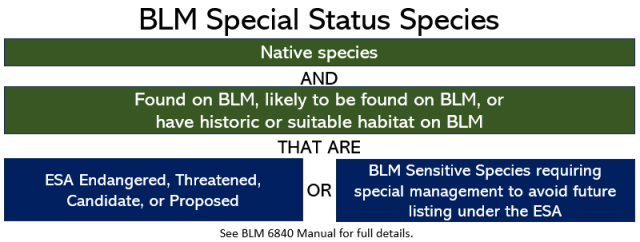
BLM special status species
BLM special status species are native species and found on BLM-administered lands, or likely to occur on BLM-administered land based on habitat characteristics, or have historic or suitable but unoccupied habitat on BLM BLM-administered lands. They also must be one of the following:
- Endangered Species Act endangered, threatened, candidate, or proposed; or
- BLM sensitive species requiring special management to avoid future listing under the Endangered Species Act.
Refer to BLM Manual 6840 for the full details.
What are threatened or endangered species?
Endangered and threatened wildlife, fish, and plants “are of esthetic, ecological, educational, historical, recreational, and scientific value to the Nation and its people.
Photo Courtesy of Cameron Rognan
Under the Endangered Species Act, plant and animal species may be listed as threatened or endangered. “Threatened” means a species is likely to become endangered in the foreseeable future. “Endangered” means a species is likely to become extinct in the foreseeable future.
The U.S. Fish and Wildlife Service, and National Oceanic and Atmospheric Administration: National Marine Fisheries Service oversee the Endangered Species Act regulations. However, the BLM plays an important role in managing and conserving threatened and endangered species habitats so that species can recover and be removed from the Endangered Species Act list.
What are proposed species?
Species of fish, wildlife, or plant that are proposed to be listed under the Endangered Species Act.
What are candidate species?
Candidate species are defined by the USFWS as species with sufficient information on their biological status and threats to propose them as endangered or threatened under the ESA. NMFS defines candidate species as species whose status they are currently reviewing to determine whether they warrant listing under the ESA. Candidate species receive no statutory protection under the ESA. Candidate species may be proposed for listing as threatened or endangered by USFWS and NMFS.
What are BLM sensitive species?
When a particular native wildlife, fish, or plant species occurring on BLM lands is at risk of becoming ESA listed, the BLM can identify the species as a BLM sensitive species. The BLM works with the USFWS, NMFS, and state fish and wildlife agency partners in making this determination. Once identified as a BLM sensitive species, the BLM works to proactively conserve these species and ensure that activities on public lands do not contribute to the need for their future listing under the ESA. Conservation goals for BLM sensitive species may be included in BLM land use plans and conservation agreements with partners.
Why do species remain categorized as BLM special status species once removed from the Endangered Species Act list?
When a species recovers and is removed from the ESA list of threatened and endangered species, it must be monitored to determine if its population is still doing well. The USFWS or NMFS develops a post-delisting monitoring plan that is in effect for at least five years, but often lasts for much longer. Monitoring helps ensure the species status does not decline again. If declines occur, additional protection measures may be needed. The BLM helps implement the monitoring plan and continue to conserve the species and its habitat.



